Thiézac, a village 30 km from Aurillac (260 km north-east of Toulouse, France) has a reputation of [color=brown][b]pure rye bread[/b][/color]. Just the sound of it is beautiful to me. When I read about it in Mouette Barboff's [i]Pains d'hier et d'aujourd'hui[/i] (page 64 - 67), I felt that had to try it. I am mesmerized by the rye bread photo and crumb shot in the book, full of soul. The book has the most beautiful bread photos I have seen anywhere.
What struck me about the crumb of the Thiézac pure rye sourdough bread is its deep caramelized color. A forum post by Danubian at Sourdough Companion, entitled [i]"Dark" or "Black" colour to rye bread[/i] in June 2007 says that the dark rye bread "colour is achieved by method rather than adding an ingredient that imparts 'colour'."
I had to consult several on-line French translators to get some sense out of the Thiézac recipe and even then I still have puzzles. For instance, about "5 à 6 kg de levain de 3 jours," to build up the levain over 3 days to 5 - 6 kg? I guess so; but how many feedings a day, and, more importantly, what is the flour to water ratio for refreshing the starter? And, stand the levain at room temperature for the whole time?
There is a knowledge bank at TFL regarding rye sour and rye flour in general, but I am really not interested enough on the subject to study. My family and myself are not rye enthusiasts. But anything "pure," as in the case here, I am all for it. A [color=brown][b]pure rye bread[/b][/color] makes me want to try it and ... dream about it.
So, here it is... the result of my dream:
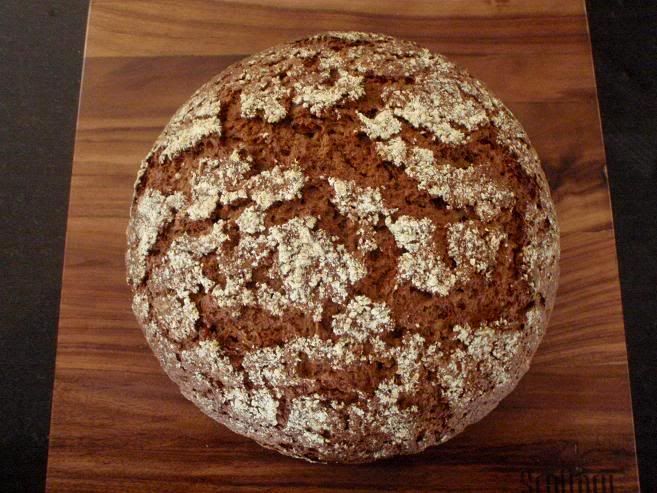
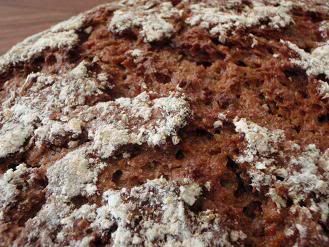
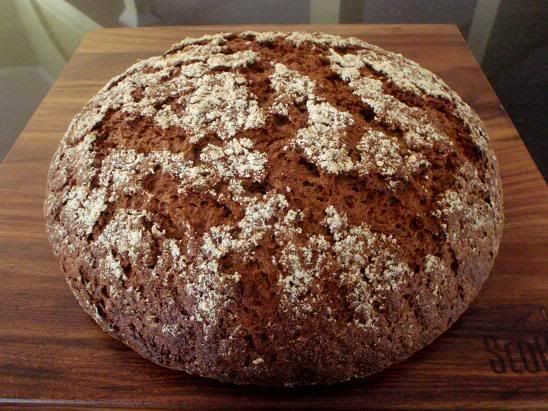
Now, I have to warn you that my result is quite different from what was in Mouette Barboff's book that inspired me. For a start, from what I can ascertain accurately from the formula figures, the overall dough hydration in the Thiézac recipe is only 53%! I cannot work on a dough with that hydration! I kept adding water until a medium soft consistency was obtained and reached 76% hydration. Further, the Thiézac rye bread has diamond scoring (3 cut on one direction and another 3 cut on another direction). My dough was too wet to attempt at any scoring.
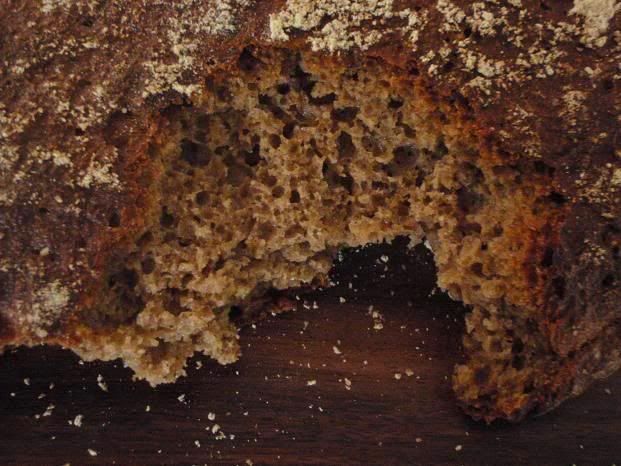
This bread is sour, too sour for my family. Because of the whole rye flour used, it also has a very nutty flavour. The aroma is simply amazing when it came out of the oven.
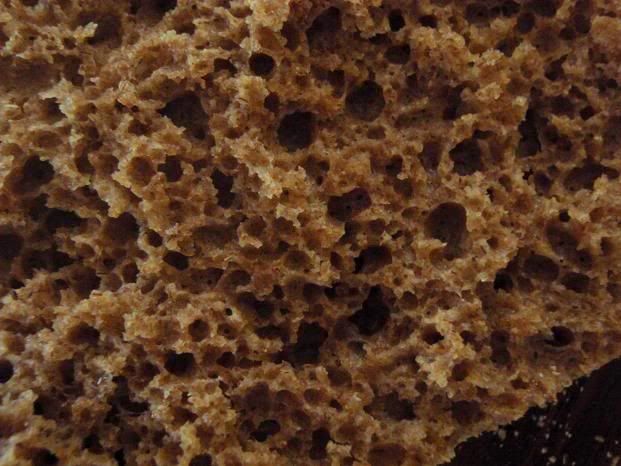
My crumb looked similar to the one in the book. To my way of thinking, if I had done the dough at 53% hydration, the crumb would have been much denser. I can only surmise that the village bakers' formula is only a guide - they would add water on the spot if they think the dough needs more water irrespective of the formula. But I don't know for sure.
Well, as nice as the bread is, my family is not the slightest interested in it.
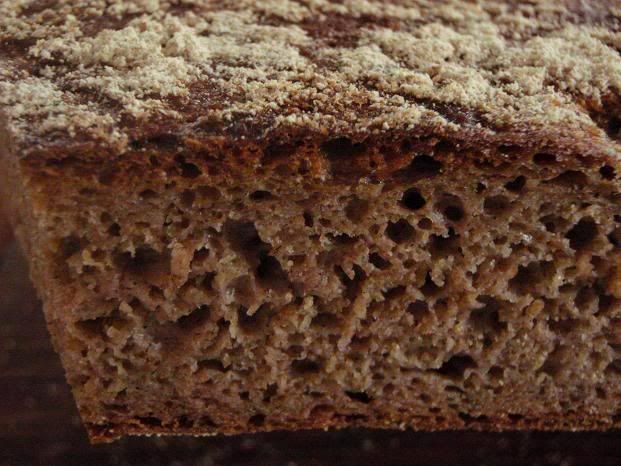
I have to pile up with something else that they like for them to eat it. And here it is:

[b]Smoke Salmon & Salad with a Dill Sour Cream Spread on [color=brown]Pure Rye Bread[/color][/b]
For any one who is interested, my formula of this rye sourdough follows:
[b][u]Day 1[/u][/b]
- 10 g any ripe starter at any hydration
- 35 g medium rye flour
- 35 water
Mix and leave it in room temperature until doubled, then move it into the refrigerator.
[b][u]Day 2[/u][/b]
- 80 g starter (all from Day 1)
- 80 g medium rye flour
- 80 g water
Procedure same as Day 1.
[b][u]Day 3[/u][/b]
- 230 g starter (all but 10 g from Day 2, reserve 10 g for future endeavour)
- 230 g medium flour
- 230 g water
Mix and leave in room temperature for 6 hours or until it doubles. (Note: I cut short one day here. The Thiézac recipe does this 6 hour feeding one day 4; ie, using "levain de 3 jours.")
[b][u]Final Dough[/u][/b]
- 690 g starter (all from above)
- 345 g whole rye flour
- 345 g medium rye flour
- 440 g water
- 20 g salt
- 2 g instant yeast (or 2 x 1/3 tsp)
Total dough weight was 1842 g and the overall hydration was 76%.
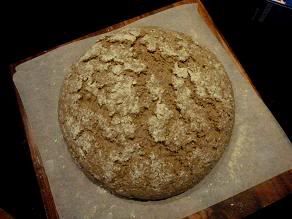
- Mix all ingredients and knead for 2 minutes by hand or by plastic scraper.
- Oil a clean bowl and place the dough in there. Cover.
- Bulk ferment for 2 hours at a warm spot of your kitchen. (My room temperature was 28C.)
- Upturn the dough onto a well-dusted surface. Lightly gather the edge of the dough to the centre, turn the dough over, and lightly shape it into a boule. Sprinkle some flour on the top.
- Sprinke some flour on a piece of baking paper. Place the dough on the baking paper. Cover, preferrably with a big bowl, so the surface of the dough remains untouched.
- Proof for one hour (and in the mean time, pre-heat the oven).
- Bake with steam at 240C for 10 minutes, then turn the heat down to 200 C and bake for a further 40 to 50 minutes.
Shiao-Ping
- Shiao-Ping's Blog
- Log in to post comments
Beautiful.
Shiao-Ping
You're a fearless baker.
Now I am scared to do my next bake!
Thank you for sharing.
I've added Rye flour to my next KAF order and as soon as I get it, I'll be giving yours a try.
Once again....Beautiful and tasty looking beads...
Look for a message in your box...
Judd
Shiao-Ping
Your logo photo looks like a rye [b]pan bread[/b]. Is it? Do you love bread made with rye flour? If you do, once you receive your rye flour from KAF, would you share your experience? I will be interested to learn how rye bread lovers find this formula.
If you think you will have problem shaping this sourdough bread as a [b]free standing loaf[/b], you may want to consider lowering the hydration by 3 - 5%. Otherwise, plenty of dusting flour would help, both on the work bench and on your hands.
Very impressive, as is all your bakes! : )
Do your mother-in-laws and grandmother bake breads?
The reason is -
(1) that the Thiézac village bakers use it;
(2) that to give you more certainty in the total fermentation time it's best to have it; AND
(3) lastly, I did try WITHOUT the IDY the FIRST time when I attempted making this bread - it was so dense. The pictures you saw in this post were from my second attempt. You know me that, nowadays, I try to NOT use any IDY at all.
Your question tells me that we think alike.
Hi Shiao-Ping, after looking at my copy and using my halting French,(Can't believe my mother is French!) I noticed it says light right and a 85% sifted rye, most likely a medium rye! As for the 3 day feeding, most likely it's a long one time feed per day, is my best guess. From my own rye levain it takes a good 12 to 18 hours to really rise, depending on how wet you maintain the levain. This being said each persons baking has it's own timing and quirks!
Looks great, I just made a Alte Deutches brot about 5 days ago, it's dense but still moist inside and is fantastic with cheese or some butter!
Jeremy
Do you think the rye starter they use is stiff starter? or liquid?
Shiao-Ping
p.s. MC told me she meets your mother regularly. Her own mother is 90+ years old. How old is your mother? Before my daughter went to Belgium, she watched the French channel to try to get her French up to speed. I would sit next to her to listen to the sing-song on the TV - doesn't matter that I don't understand a thing!
Wow again. Beautiful loaf of bread, and impressive considering the percentage of rye!
I have found myself craving rye bread lately. I don't know why, because I've never tasted a dark rye before. Maybe it looks dense and warm and comforting during these winter months. Anyhow, I baked my very first rye (80% Sourdough Rye with a Rye Soaker from Hamelman's "Bread") and it is patiently waiting for another 18 hours or so before I cut into it. So, I think this will be the first of many rye loaves- but I'd like to hear of your experiences with it as from prior posts of yours I can tell we think alike in a lot of ways. I will be moving on the the Demolter ryes- which are similar in method to the Thiezac you just made. Will you be continuing with Rye? Do you like the flavor? You say your family didn't care so much for it (at least this loaf)- and I know you and I like similar things as I'm always drooling over your posts and then printing them to be added to my long "to-bake" list.... :-) Would you recommend the rye with apple over this one? I'm looking for a really dense, moist, sweet loaf- that I can bake in a pullman...Something about the strong square shape that draws me to it.
Tons of questions and rambling, I know. I'd just like to hear your thoughts and opinions on Rye and if you are happy with the flavor so far or are done with rye.
Thanks for this post- inspiring.
Hi
We used to bake 2 types of all-rye bread in tins in the artisan bakery I worked in. Our hydration levels were upward of 85%, and the product sat in the bakery for 24 hours before despatch. We had a full 7 days shelf life.
The real knack is to choose the right shape of tin: tall and narrow works well; wide and flat is far less attractive.
I presume this loaf featured was baked as one very large loaf. Did you feel it was too wet to prove in a banneton? I note you proved on silicone paper, presumably dropping this straight onto the sole of the oven, or a pizza stone?
It looks wonderful, and you are quite right that hydration at 53% would produce a havy and dry brick.
Hamelman has some great ideas for building rye cultures.
We were making literally tons of rye sourdoughs virtually daily, so you can imagine just how active the culture was.
Andy
In England, have you ever heard of Mathias Dahlgren's name? He is a Swedish chef. I did a variation of his Swedish Rye Bread with apple puree and its hydration was around 85%, a most delicious rye sourdough that I have ever tasted!
Thanks for the tip that the shape of the tin in which the rye bread is baked makes a difference in viewing (and tasting) pleasure! I hadn't thought of that.
Re your questions -
(1) I wanted the natual lava-rock look as the rye flour fermented, so I opted to prove the dough on a piece of baking paper (not silicone paper). I guess a 76% hydration isn't all that high if I wanted to prove it in a banneton. But then again I haven't had good luck so far with bannetons. Hansjoakim is one of the many home bakers here at TFL who does a great job with rye in a banneton (see this beautiful example).
(2) The sole of the oven? Do you mean the bottom of the oven? I use a baking stone.
You are right that Hamelman has great ideas for building (and maintaining) rye cultures. I recently read MC's post of [i]Jeff Hamelman on maintaining a rye starter[/i] on her blog, farine-mc.com. It was very good of her for sharing that information with home bakers.
Would love to hear from you about the type of rye breads that you made in the artisan bakery you worked in.
Thank you.
Shiao-Ping
Hi Shiao-Ping,
I haven't come across Mathias Dahlgren. Our Rye breads were heavily Russian-influenced, as the owner of the business had worked for BBC World Service as a journalist with Russian expertise. I did have a quick look at your link to the apple bread, and noted you had used molasses in that bread formula. I think this an exceptional ingredient to use with rye sour; treacle is a very poor substitute.
We made 2 all rye sourdough breads. One was called Rossisky, and the other "Borodinsky". This one was flavoured with a coarsely ground Coriander [grind described as "fine cut"], together with malt extract, and...black strap molasses. I will come back to you with more details about these breads soon. At the moment I'm flat out on an MSc assignment, having been snowed in at home for 4 days. I need to access my work pc to get more detail for you, and need some time to process this. Will post on my blog soon as I can.
I've had problems with bannetons and high hydration rye breads before; thanks for pointing me to Hansjoakim, his work is quite special. Also too the links relating to Hamelman and MC. I look forward to finding time to delve into these more deeply. I think it is a matter of getting 2 things right. Proofing conditions need just the right amount of humidity, and the banneton needs to be clean, dry with a judicious amount of dusting used. Someone on TFL swears by rice, and in the bakery world we use "rice cones" which are great for wicking moisture. A coarse semolina is pretty good too.
Sole of the oven is the floor, since I bake in a deck oven at work, so use a peel to set all the bread in my bakery classes. At home I have 3 bricks in my oven with a thin metal tray on top. I turn all my breads out of bannettons onto the tray and bake on the bricks. This is instead of the pizza stone, but I have heard only good things about these.
More later, but lovely to hear from you
Thanks
Andy
ps. One other tip for anyone using tins. Rye bread sticks like glue, so, be very thorough in greasing the tin. I used to melt palm fat, then brush it on very carefully to achieve a full and uniform coat. Then cool the tins quickly so the fat sets without running into the bottom to form a pool. Coated tins are great, but our experience is that the excess acidity of the sour dough eats away at the poly coating pretty quickly. So, you need access to re-coating these tins for use on a longer term basis!
Hi Andy
Thanks for your reply and look forward to reading more about rye bread in your blog. I made Hamelman's Demolter rye bread yesterday morning (the Three-Stage 90% Sourdough Rye) and this morning I had a very thin slice of it (it tasted drier than my Thiezac rye bread in this post). There is a beautiful description of this "long trail rye bread" of Hamelman's younger days in his [i]Bread[/i], p. 201. Somehow, though, the story and the bread reminded me of Tibet and what people eat in the highlands over the Himalayan range of mountains, essentially barren country where crop don't survive. If you ever read adventure or travel stories of Tibet, you will come across a dry dough concoction (more like big-sized bread crumbs, cooked over fire) which Tibetans carry to keep them from starvation in their long "trail" over the snowy mountains and which can last for months. Tibetans eat this dry dough with piping hot "butter tea." You can appreciate how delicious it can be if you were hiking and there were 3 metre's deep of snow around you. This dry dough concoction is made of flour from grains which my (and your) climates don't grow much (we have more delicious varieties to grow). Pilgrims talk about this dry dough with fond memories and great affection and there're even romances built around it. Because I have not grown up with it and feel no emotional bondage, I try to understand it on an intellectual level. And, so far, this is how I look at rye bread (assisted with first hand experience). I just wonder if the emotional piece was stripped away and if people who live in the barren high country can also grow rice, wheat, etc, would they choose to eat rye? Sorry, I sounded prejudiced.
Shiao-Ping
It is very interesting that you should mention that the Demolter rye bread is similar to Thiézac rye bread. I hadn't put two together. You may be right as there appear to be striking similarites between the both methods, although one is German and the other is French. It's possible that Thiézac's rye "levain of three days" is similar to Demolter's rye sour built over three stages. But I can't be sure. I am really not a student of rye flour.
I am in the process of making the Demolter rye, just to compare. I have a feeling that the end result may be similar to Thiézac rye bread. The reason why I am making the Demolter rye is to give myself another chance to try to like the pure rye bread. I think the taste of pure rye bread is for people who live in much colder climate. Our climate in Australia is very mild. We tend to eat more light food becaue of the mild weather (and I am not just talking about our summer).
So far the rye bread that I like the best is my apple and molasses Swedish Rye Bread. I can eat that in small quantity and savor every bit of it. I do recommend this over Thiézac rye bread. I think to improve the latter to my taste, I'll have to increase its hydration to at least 85%, or even 90%, and use a loaf tin to bake, instead of free standing as in my post.
Well, I am not done with rye yet (but I am optimistic either).
I am very happy to learn that our tastes are similar and would love to hear what you think about the 80% rye that you've got waiting for you to slice.
Thanks.
Shiao-Ping
Thanks for getting back to me :-)
I cut into the 80% rye and was pleased but not overly so. I knew going in that this bread would just be a starting point, and then I would build up in both ingredients and method from there. So overall, I am happy with it- but the last half of the loaf will probably become the altus for my next loaf. I'm looking for something a lot more moist, dense and chewy with whole rye or cracked rye in it- something like that. Also, your addition of the applesauce sounds tempting- it might add the right effect. I agree with you, however, that I'd like to give a chance to the rye itself for providing the sweetness before playing with additions.
For a little better explaination, I wrote a little entry about my first rye here.
Thanks for the response and your posts. Keep em coming!
Hi Shiao Ping,
I'm French, live between Robertson and Sydney, and I'm trying to bake a Rye bread every week already 18 months since I came back from the region you are talking about. I can tell you all my experiences and failures and success, it will be too long, it go through my misunderstanding of how to do a right sourdough, to my adament willing to use a 100% sourdough rye ..., now I'm almost there by using the no knead method or the classic method with foldings and long fermentation for at least 24 hours and using the dutch oven way to bake ( my old electric oven was burning the breads on one side... and I could not control the humidification of the baking.) I can and will be delighted to also translate for you anything from French to English. Just ask.
I admire your capacicity to put all those photos on the site and to be able to talk about every thing you are baking ! I'm still trying to find the right recipe which will give me everytime the same bread without too much crumb, french like crust more than crumbs. An this kind of bread is not to be use for sandwishes but for savoury and rich little morsel of salmon, cheese, and salted butter !
I realized that too much info and many times not precise enough bring you to make more mistakes. The number of methods seems to be as the number of bakers... errors in typo in baking books are a catastrophy.
here is my email address if you prefer this way to communicate ( I do ! ) Beatrice (bee18) bea2003@optusnet.com.au
Thanks so much for your information. Eighteen months of baking a rye bread every week sounds like an admirable endeavour. The description of your "almost there" rye bread by using the classic method of foldings and long fermentation for at least 24 hours sound fabulous to me! Can I send a good friend who lives in Sydney to pick up a rye bread from you? I am kidding. But thanks so very much for your offer to share your experience. I would love to take it up.
Just one quick question: master bakers' advise on rye has always seemed to be for quick but gentle kneading (and no, or few, foldings necessary as rye has no gluten forming protein) and quick fermentation under warm condition. But your method is foldings plus [b]long[/b] fermentation. That sounds intriguing.
Thank you.
Shiao-Ping
Yes, my mother bakes. Never was there a day when I came home from school without there being some sort of baked goodie waiting for me!
My mother often made steam buns when we were little. On cloudy, wintry mornings, she would use the same dough and made pan-fired onion/shallots pancakes. Or, sometimes, she used the same dough and made steamed meat buns. In a child's mind, nothing is more heavenly than this waiting for you when you get home!
Shiao-Ping
Hi Shiao-Ping, I want to give that formula a try but I have been so busy, have to crunch the numbers and see how the bread would be with the lower hydration?
Yes MC and my mom have met a few times, my mom is in her 70's. She likes practicing her French and MC is so wonderful, a bright star and great baking advisor!
Cheers,
Jeremy
Shiao-Ping
Shiao-Ping, send me your e-mail and I can send you some rye recipes to try if you like?
Jeremy
jergra@mac.com
Shiao-Ping